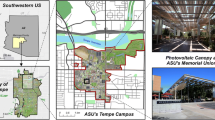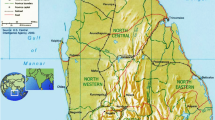Abstract
The plumes from the Kuwait oil field fires reduced hemispheric (total) solar radiation by 26–36% during January–June 1991 in Jubail (300 km SE of Kuwait City), Saudi Arabia. Residents feel noticeably cooler even though air temperatures have not been lowered significantly (up to June 1991). These observations support human comfort theories and demonstrate the importance of shade to comfort. The desirability of complete solar radiation measurements, including those of diffuse radiation, is indicated.
Similar content being viewed by others
References
Bakan S, Chlond A, Cubasch U, Feichter J, Graf H, Grassl H, Hasselmann K, Kirchner I, Latif M, Roeckner E, Sausen R, Schlese U, Schriever D, Schult I, Schumann U, Sielmann F, Welke W (1991) Climate response to smoke from the burning oil wells in Kuwait. Nature 351:367–371
Browning KA, Allam RJ, Ballard SP, Barnes RTH, Bennetts DA, Maryon RH, Mason PJ, McKenna D, Mitchell JFB, Senior CA, Slingo A, Smith FB (1991) Environmental effects from burning oil wells in Kuwait. Nature 351:363–367
Cermak JE (1975) Applications of fluid mechanics to wind engineering. J Fluids Eng 97:9–38
Dolan M (1991) Fires threaten health and crops. LA Times: 24 Feb, A9
Duffie JA, Beckmann WA (1974) Solar energy thermal processes. Wiley, New York, pp 43–48
Economist (1991) Tragic not catastrophic. 30 Mar, p 39
Fanger PO (1970) Thermal comfort — Analysis and applications in environmental engineering. Danish Technical Press, Copenhagen, pp 128–133
Gagge AP, Gobblets AP, Berglund LG (1986) A standard predictive index of human response to the thermal environment. ASHRAE Trans 92(2B):709–731
Horgan J (1991 a) Up in flames — Kuwait's burning oil wells are a sad test of theories. Sci Am 264:7–9
Horgan J (1991 b) Burning questions-scientists launch studies of Kuwait's oil fires. Sci Am 265:17–24
Ibrahim YM (1991) Blazes could burn 2 more years. NY Times: 16 Mar, p 4
Kennedy JM (1991) Smoke billows from Wafra oil filed torched by Iraqi troops [AP Photo story]. LA Times: 24 Jan, A7
Kennedy JM, Healy M (1991) 150 wells set ablaze. LA Times: 23 Feb, A1
LA Times (1991) Black rain on Bushehr Province of Iran. 24 Jan, A7
Martin M, Berdahl P (1984) Characteristics of infrared sky radiation in the United States. Solar Energy 33:321–326
Rosenwicz B (1991) Iraqis set fire to oil sites in Kuwait. Wall St J:23 Jan, A3
Simons M (1991) British study disputes lengthy climatic role for Kuwait oil fires. NY Times: 16 Apr, C4(L)
Small RD (1991) Environmental impact of fires in Kuwait. Nature 350:11
Snedecor GW, Cochran WG (1967) Statistical methods 6th edn. Iowa State University Press, Ames, Iowa, USA
Sullivan A (1991) Gear, mine problems slow effort to end Kuwaiti oil fires more than expected. Wall St J:8 Mar, A3
Yoklic MR (1988) Public space climate control: a solar oasis for a desert city. Proceedings Passive Solar Architecture 1988, Bled, Yugoslavia, pp 360–367. Published by Slovenc Solar Energy Society, 61000 Ljubljana, Yugoslavia
Author information
Authors and Affiliations
Rights and permissions
About this article
Cite this article
Riley, J.J., Hicks, N.G. & Thompson, T.L. Effect of Kuwait oil field fires on human comfort and environment in Jubail, Saudi Arabia. Int J Biometeorol 36, 36–38 (1992). https://doi.org/10.1007/BF01208732
Received:
Revised:
Accepted:
Issue Date:
DOI: https://doi.org/10.1007/BF01208732




